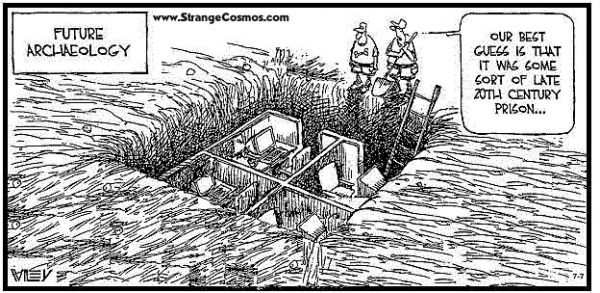In its distinctively playful way, Google Australia takes the business of creating a stimulating workplace to increase employee satisfaction and performance seriously. The evidence is in the company’s recently completed Pyrmont, Sydney headquarters. The part of the Google empire that created Google Maps and Google Wave emphasises fun with a number of Australian-themed areas including offices with picnic benches, fish tanks, local flora, the beach-themed Café Esky and a games room. Google chefs also provide free breakfast, lunch and dinner. The 400 Australian Googlers can take a break from work by relaxing in a hammock, bean bag or lounge chair while playing on one of the three games consoles and a wide range of board games. There’s also pool and ping pong tables, and a webcam that allows workers at their desks to check if the equipment is being used.The company was voted Australia’s number one employer in a recent survey.
Capitalising on the Best Management Thinking and president’s distinguished professor of information technology and management at Babson College in the US. In leaner and meaner times, “many workers are even reluctant to be seen using these facilities for fear that they won’t be considered hardworking enough”, he says. “There’s no clear relationship between knowledge worker performance and various appealing features of the work environment, though they may help slightly with recruiting and morale.
A look around Google HQ raises a big question: How much difference does the physical working environment make? There is no evidence that anyone ever took or stayed at a job, or worked more productively because of games, cappuccino bars, office concierges, conversation pits and creativity, relaxation or nap rooms, according to Thomas Davenport, co-author of What’s the Big Idea: Creating and
” Building a successful business has little to do with aesthetics, admits Sarah Kay, who heads the interior architecture team at global design studio Woods Bagot, which has worked on projects for Google, National Australia Bank, Macquarie Group, ANZ and the University of New South Wales (UNSW). Although Kay also believes an appealing working environment can lure workers and clients – and, “it can encourage desired behaviours in an organisation that wants to evolve”. When designing a workplace, the aim is to respond to the business and cultural drivers of an organisation, Kay insists. “Combined with the right systems and cultural change, physical space can make a huge difference to the speed in which change is adopted,” she says.
The most important consideration in a workplace environment is not the fun and games, says Sue Serle, a lecturer in the Interior Architecture Program at the Faculty of the Built Environment at UNSW. What’s paramount, in Serle’s view, is tailoring the physical settings to the activities and needs of the worker. While this may seem obvious, she says many employees work in spaces where the physical structure is poorly suited to the tasks at hand and this hampers productivity. “Activity-based settings may include systems furniture made up of a number of components that can be changed to meet different needs, such as a screen to enclose a workstation if more privacy is needed, or a table that can be moved around to accommodate meetings,” says Serle. industrial design at UNSW. “In the past, industrial designers tended to focus on individual office furniture items or fittings that looked beautiful,” he observes. “But now there’s a more fundamental approach where companies such as (US office furniture manufacturer) Herman Miller are conducting extensive research into prototypes that fit with the experiences of workers and work culture.” A study by Herman Miller has into prototypes that fit with the experiences of workers and work culture.” A study by Herman Miller hasidentified seven workspace attributes that workers value and which presumably contribute to their satisfaction and output. In order of priority, workers want a comfortable office, a sufficient amount of work surface area in the office, the option to put the computer in the most suitable location and the capability to keep work within arm’s reach, to contain sounds within the office, to keep out distracting noises from outside the office and to have “visual privacy”. Many of these attributes have also been bandied about in one of the hottest ongoing arguments about creating a productive, cost-effective workplace environment – open-plan office space versus the comparative privacy of the closed cubicle. Miles Park, program director of The trend is definitely towards a more user-centred approach, says
Wide Open Spaces
Since the early 1990s, the merits of open plan offices and hot-desking – the practice of temporarily assigning desks to casual and/or permanent staff – have preoccupied commercial office designers. “Hot-desking and open-plan layouts are popular for two reasons,” notes Cameron Fitzpatrick-Ramirez, a researcher in organisation and management at the Australian School of Business. “Proponents argue that they offer managers cost savings in accommodation overheads and can supposedly influence the behaviour of workers in a positive direction,” he says. But these assumptions fail to take into account the negative impact of open and flexible office designs on employees. “Factors such as the lack of a personal workspace, increased distractions that workers cannot control and the continual movement from place to place are frequently unacknowledged side effects,” says Fitzpatrick-Ramirez. Not only do these adverse effects present hidden costs, but they potentially shoot down the managerial rationale that architecturally driven strategies will deliver productivity gains, he says.
A 2009 study into open-plan offices by Queensland University of Technology’s Institute of Health and Biomedical Innovation published in the
Asia Pacific Journal of Health Management also found high levels of noise caused employees to lose concentration, leading to low productivity, and workers felt insecure because of lack of privacy. “In 90% of the research, the outcome of working in an open-plan office was seen as negative, with open-plan offices causing high levels of stress, conflict, high blood pressure and a high staff turnover,” reports researcher Vinesh Oommen. Open-plan offices work only if they are designed correctly and when they fit the strategy and culture of the workplace, argues Serle. “Even then, private quiet spaces, meeting areas and social breakout spaces may be needed to support workers,” she says.
At Macquarie Group’s offices in Shelley Street, Sydney, the investment bank and financial services organisation believes it has open plan right. It offers its 3300 workers “activity-based working” – a mutation of the open-plan and hot-desking concepts developed by Dutch designers at
Veldhoen + Company which has worked on about 100 similar projects in The Netherlands. While an employee has an anchor point, a “home base” with a locker and storage, no one has an assigned desk. Rather, the workspace provides employees with a variety of tailored work settings for specific tasks. That may be having a meeting, writing a report, or collaborating on an idea, with different work stations designed to accommodate activities.
The design is about flexibility and choice. “Shelley Street is both a metaphor as well as an enabler of our culture,” says Peter Maher, Macquarie’s head of banking and financial services. “The nature of the markets in which we operate is dynamic, so the space in which we operate should be dynamic and the two can work hand-in-hand in terms of how we evolve.” While no research has been conducted directly into the impact of the design on productivity, a study into engagement showed 93% of employees preferred the new style to working in a more conventional office.
Dressing Down for Success?
For the employer who prefers to know where their employees sit, introducing a more relaxed tone to an office can involve something as simple as adopting casual dress codes – and this is perhaps a safer option, says
Julie Cogin , head of Organisation and Management at the Australian School of Business. Such measures can remove barriers to communication, she believes. Like Serle, Cogin suggests employers get the basics right first – and that includes design. Even light, colour and artwork play a part in employee satisfaction and productivity, she says. The headquarters of National Australia Bank (NAB), one of Australia’s big four banks, in the Melbourne Docklands precinct is one example. Glare screens on the exterior of the building reflect daylight onto the ceilings ensuring that NAB staff work in natural light all day. Thanks to a saw-tooth roof, sunlight also penetrates the building even on overcast days. Other design features include the selection of low-gassing materials, Mirra task chairs, which shift to the user’s body shape, and a plant-lined atrium that absorbs toxins and refreshes the air inside.
But do such workspaces enhance productivity? The physical working environment plays an important role in promoting innovative thinking.”To generate ideas, employees need to be stimulated,” according to Gary Bertwistle, founder of Australia’s first dedicated creative space, The Ideas Vault, in Sydney. Bertwistle designed the octagonal “vault”, featuring natural light and plenty of colours, specifically to enable companies and groups of people to create better ideas for their business or projects. “The brain needs light and colour as well as unusual angles, pictures – anything that gets away from beige and boring,” Bertwistle says. Certainly a place to retreat, such as a games or a coffee room, made most top 10 lists in a 2006 study by the International Facility Management Association. A resounding requirement of survey participants was for a space that offers one or more places to escape where individuals can go for distractions and to focus on work tasks or personal matters.
Bertwistle says retreat areas are appealing because employees need to be relaxed to be able to solve problems and learn. “Increasingly, corporate clients are designing these breakout areas into their buildings,” he says. Not all employers are inclined or able to offer the aesthetic and activity fun factor of the Google workspace – and such an approach offers no guarantee of positive outcomes, insist the experts.”If the office culture is toxic, it’s like putting lipstick on a pig,” suggests Bertwistle. Even Kay acknowledges that while cutting-edge design is sought after by blue-chip clients, giving employees the sense that they are trusted and valued is a more subtle and effective way to increase productivity. Cogin sums it up: “Aesthetics are just the first layer and they are only going to work if they are aligned with deeper levels of change.” Shifting a workplace culture requires more than moving the furniture. Real productivity benefits come from what happens behind those aesthetically winning exteriors. Behavioural changes may be required, along with a focus on leadership styles, communication, career development and work/life balance, Cogin says. In the end, she says the fun and flexible fit-out is no substitute for “decision-making that includes consultation, input for all relevant stakeholders, and rewards and incentives for teams rather than individuals”.


